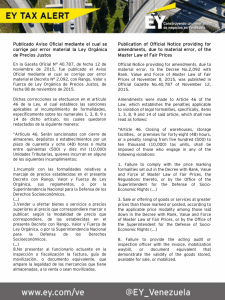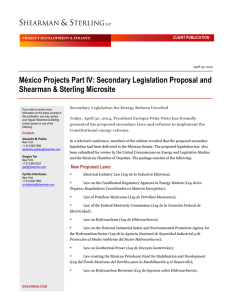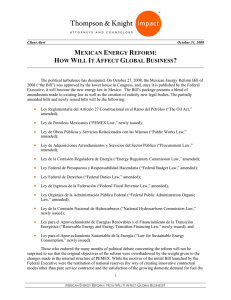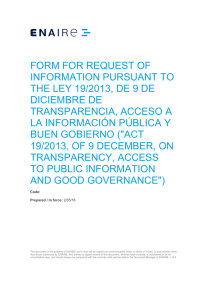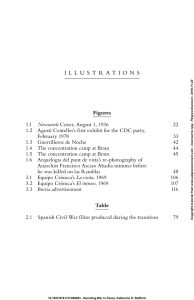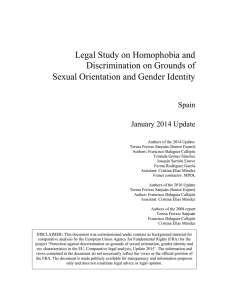Agenda Dynamics in Spain
Anuncio
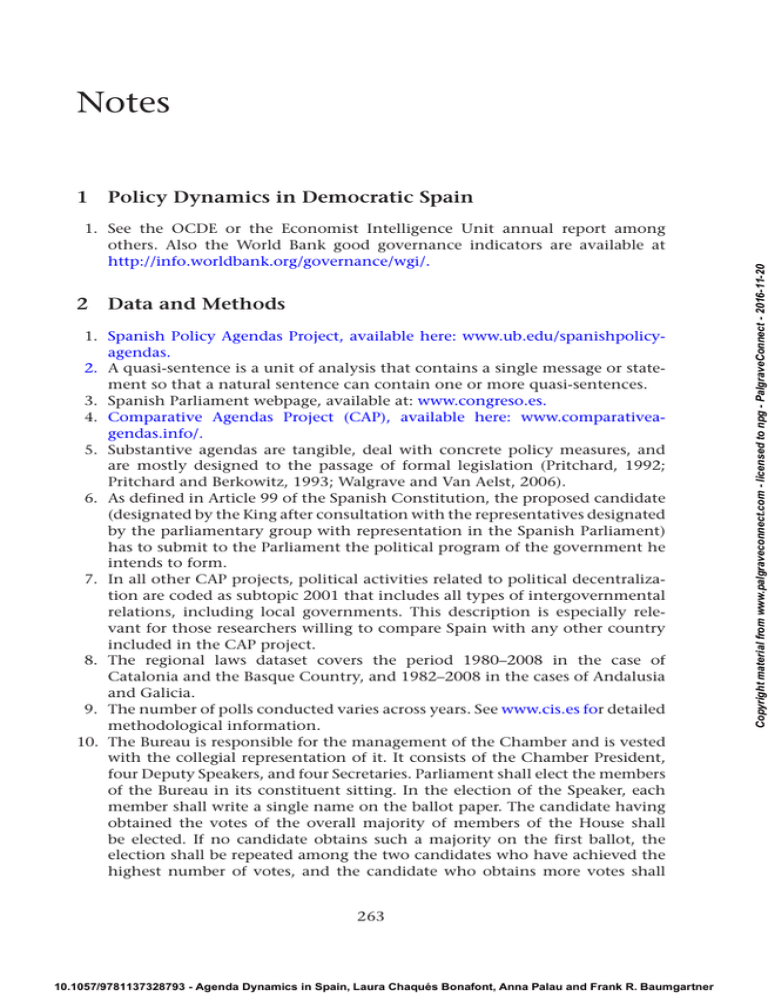
Notes Policy Dynamics in Democratic Spain 1. See the OCDE or the Economist Intelligence Unit annual report among others. Also the World Bank good governance indicators are available at http://info.worldbank.org/governance/wgi/. 2 Data and Methods 1. Spanish Policy Agendas Project, available here: www.ub.edu/spanishpolicyagendas. 2. A quasi-sentence is a unit of analysis that contains a single message or statement so that a natural sentence can contain one or more quasi-sentences. 3. Spanish Parliament webpage, available at: www.congreso.es. 4. Comparative Agendas Project (CAP), available here: www.comparativeagendas.info/. 5. Substantive agendas are tangible, deal with concrete policy measures, and are mostly designed to the passage of formal legislation (Pritchard, 1992; Pritchard and Berkowitz, 1993; Walgrave and Van Aelst, 2006). 6. As defined in Article 99 of the Spanish Constitution, the proposed candidate (designated by the King after consultation with the representatives designated by the parliamentary group with representation in the Spanish Parliament) has to submit to the Parliament the political program of the government he intends to form. 7. In all other CAP projects, political activities related to political decentralization are coded as subtopic 2001 that includes all types of intergovernmental relations, including local governments. This description is especially relevant for those researchers willing to compare Spain with any other country included in the CAP project. 8. The regional laws dataset covers the period 1980–2008 in the case of Catalonia and the Basque Country, and 1982–2008 in the cases of Andalusia and Galicia. 9. The number of polls conducted varies across years. See www.cis.es for detailed methodological information. 10. The Bureau is responsible for the management of the Chamber and is vested with the collegial representation of it. It consists of the Chamber President, four Deputy Speakers, and four Secretaries. Parliament shall elect the members of the Bureau in its constituent sitting. In the election of the Speaker, each member shall write a single name on the ballot paper. The candidate having obtained the votes of the overall majority of members of the House shall be elected. If no candidate obtains such a majority on the first ballot, the election shall be repeated among the two candidates who have achieved the highest number of votes, and the candidate who obtains more votes shall 263 10.1057/9781137328793 - Agenda Dynamics in Spain, Laura Chaqués Bonafont, Anna Palau and Frank R. Baumgartner Copyright material from www.palgraveconnect.com - licensed to npg - PalgraveConnect - 2016-11-20 1 11. 12. 13. 14. 15. 3 then be elected. The four Deputy Speakers shall be elected simultaneously. Each member shall write a single name on the ballot paper. The four candidates obtaining the highest number of votes shall be elected in that order. The four Secretaries shall be elected in the same manner (Chamber rules, art. 37). Spokespersons of parliamentary groups make up the Board of Spokesmen. Meetings of the Board are chaired by the Speaker of Parliament (Chamber rules, art. 39). Delegation can occur through an act of basic principles (Ley de Bases) that contains authorization to pass a text in sections (texto articulado), or through an ordinary law designed to consolidate several legal statutes into one (texto refundido). Executive bills are initiated within a ministerial department, and once passed in the Council of Ministries they go directly to the Parliament where after publication in the Boletín Oficial de la Cortes they initiate the formal legislative procedure. Shannon’s H Entropy = – Ʃ p(xi)*logn p(xi) where xi represents a dimension, p(xi) is the proportion of total attention the dimension receives, and logn p(xi) is the log of the proportion of attention the dimension receives, using the total number of possible dimensions as the base of the log (Boydstun et al., 2014). To calculate media attention to different topics we have considered only those stories with political content for the period 1996–2011. Broken Promises 1. http://eur-lex.europa.eu/legal-content/AUTO/?uri=CELEX:31983L0129&qid =1403776738007&rid=4 2. The process took place with a too-long delay, but despite the resistance of many Cajas, in early 2010, 27 Cajas (out of 45) were already involved in merge processes. A large set of reforms were developed including tightening rules on how banks value their portfolios (like acquired properties), and increasing transparency on their balance sheets (mainly developed to avoid any possibility of hiding bad loans) (see Royo, 2013, for a description). 3. For example, this means from 2010, elected officials could not be members of the governing board of saving institutions (with some exceptions like La Caixa, where about 25 percent of the governing board were politicians) (see Royo, 2013, for a description). 4. According to Article 135.3, limits on public debt will be determined by the reference value established by the treaty on the functioning of the EU, currently at 60 percent of GDP. Indirectly, debt dynamics will also be constrained by a limit on the general government’s structural budget deficit (Article 135.2). All these agreements are further developed by organic law, which in any case cannot surpass the 3 percent of the GDP, with some margin of variation depending on external circumstances. 5. All data is available at the IGAE (Intervención General de la Administración del Estado, Gobierno de España) and also the OCDE economic indicators. 10.1057/9781137328793 - Agenda Dynamics in Spain, Laura Chaqués Bonafont, Anna Palau and Frank R. Baumgartner Copyright material from www.palgraveconnect.com - licensed to npg - PalgraveConnect - 2016-11-20 264 Notes 265 6. See http://observatoridepoliticaexterioreuropea.wordpress.com/espana-eneuropa/ 7. The alliance of civilizations is an initiative proposed by José Luis Rodríguez Zapatero at the 59th General Assembly of the United Nations in 2005. It was co-sponsored by Turkish Prime Minister Recep Tayyip Erdoğan. The goal of the initiative was to defuse tensions between the Western and Islamic worlds. To read more about the initiative see www.unaoc.org. 8. The Gobernadores Civiles were created in the nineteenth century and for more than a century have been a symbol of political oppression. Formally, they were the institutional representatives of the Spanish government in each of the provinces in Spain. Among other things, they were in charge of the police. The Constitution did not mention this institution. Despite this, it took more than two decades to eliminate the Gobernadores Civiles, which occurred in 1997 (Ley Orgánica 6/1997, de Organización y Funcionamiento de la Administración General del Estado) (see Baena, 1997). 9. Actually, some regional governments already developed specific relations on this issue. In Catalonia, Miquel Caminal Badia was the first director of the Memorial Democràtic, created in 2007. 10. One of the most visible cases of this failure is the assassination of Yoyes in the hands of ETA in 2006, after leaving the terrorist group. There is a vast literature about terrorism in Spain (see Sanchez Cuenca, 2001; Muro, 2008; Llera, 1993, among others). 11. There is only one short episode of conversations between the PP and ETA in 1998 (the first unilateral truce of ETA). For about 14 months, the PP government negotiated with ETA, arriving to some important agreements like the reallocation of 100 ETA prisoners to prisons located in the Basque Country. 12. The “Acuerdo por las libertades y Contra el terrorismo” is a document of 10 articles signed by the PP and PSOE, December 8, 2000. This document is available at http://www.interior.gob.es/. 13. Newspapers widely covered this declaration of Rajoy. See, for example, Rajoy: “Usted traiciona a los muertos y ha revigorizado a una ETA moribunda,” El País, May 12, 2005. 14. The Ley Orgánica 7/1985 de 1 de Julio sobre derechos y libertades de los extranjeros en España (so-called Ley de Extranjería) had three main goals: (1) to respond to one of the requirements related to joining the EEC (actually to incorporate mechanisms to deal with immigration were of little practical relevance in Spain, given the very small immigration flows in the 1980s); (2) to eliminate the existing regulatory dispersion; and (3) to define the goals of immigration policy according to European demands, primarily border control. 15. Ley Orgánica 4/2000 de los Derechos y Libertades de los Extranjeros y su Integración Social (Organic Law about the rights and freedom of foreigners and their social integration). 16. Ley Orgánica 8/2000 and Ley Orgánica 11/2003 de medidas concretas en material de seguridad ciudadana, violencia doméstica e integración social de los extranjeros. 17. Ley Orgánica 2/2009 de 11 de diciembre, de reforma de la Ley Orgánica 4/2000, de 11 de enero, sobre derechos y libertades de los extranjeros en España y su integración social. 10.1057/9781137328793 - Agenda Dynamics in Spain, Laura Chaqués Bonafont, Anna Palau and Frank R. Baumgartner Copyright material from www.palgraveconnect.com - licensed to npg - PalgraveConnect - 2016-11-20 Notes Notes 18. See, for example, “Determinantes de la brecha salarial de género en España”, Consejo Superior de Cámaras en Colaboración con el Ministerio de Sanidad, Servicios Sociales e Igualdad. 19. Along the first term, the PP also concluded the process of political decentralization and transfer of issue jurisdiction of health and education issues to those CCAA that followed the slowtrack to become CCAA. See Chapter 6 for further details. 20. Family policy was defined by the Plan Integral de Apoyo a la Familia (Integral plan to support families), and Ley 39/1999 para promover la conciliación de la vida familiar y laboral de las personas trabajadoras. 21. Families, and especially women, assume the responsibility of taking care of the young (education from 0 to 3 is noncompulsory and the number of public nurseries does not cover existing demand); the aged (pensions, especially widow pensions, are lower and public residences do not cover existing demand either, forcing the elderly to rely on their adult children); and the unemployed (more than 25 percent of Spaniards under 30 live with their parents, a pattern that is particularly strong among those who are unemployed or not fully secure in their positions). 22. Parliamentary rules guarantee these privileges, without major modifications from 1978 to present. First, parliamentary rules establish all governmental bills should be taken into consideration and discussed in full in the Congreso de los Diputados. That is, in contrast to other advanced democracies, the Spanish Parliament do not have the capacity to veto executive bills a priori (Döring, 1995, 2001). Second, all MPs can introduce amendments to executive bills. However, most of the time the governing party has the majority of seats in the Spanish Parliament, or sets stable governmental agreements with small and regional parties (see Table 2.2), the adoption rate (percentage of bills passed into law) is very high. Finally, the party in government also has special prerogatives to pass laws in case of urgent need, the so-called decreelaws (see Chapter 2). All decree-laws have to be ratified within 30 days by the Congreso de los Diputados, and in contrast to executive bills, MPs cannot introduce any amendments to their content – the voting is a yes or no to the overall content of the decree-law – (Guerrero, 2005). This is a major difference in relation to executive bills, which in more than 75 percent of the cases are passed with at least one amendment. 23. Note that in some cases, parliamentary groups may decide to introduce a bill dealing with the content of a decree-law. The purpose of this initiative is to guarantee the discussion about issues that are considered of special relevance. Still, this may end up being a symbolic procedure without major political consequences. 24. Note that final voting of laws is only possible for the case of organic laws and decree-laws, so these results only refer to these two legislative instruments (see Table A3.1 in the appendix for a full technical explanation). 4 The Content of the Government-Opposition Game 1. If we take into consideration a poll from the Centro de Investigaciones Sociológicas (www.cis.es) conducted in 2009. 10.1057/9781137328793 - Agenda Dynamics in Spain, Laura Chaqués Bonafont, Anna Palau and Frank R. Baumgartner Copyright material from www.palgraveconnect.com - licensed to npg - PalgraveConnect - 2016-11-20 266 267 2. Resolución de la Presidencia del Congreso de los Diputados, de 18 de Junio de 1996, sobre el Desarrollo del artículo 188 del Reglamento, relativo a pregunta para respuesta oral en Pleno; Resolución de la Presidencia del Congreso de los Diputados, de 10 de junio de 2008, sobre desarrollo del artículo 188 del Reglamento, relativo a preguntas para respuesta oral en Pleno (modificada por Resolución de la Presidencia, de 28 de diciembre de 2011). 3. Note that all calculations are made from 1986 mainly because it is only from 1986 when the board of the Congreso de los Diputados introduced some rationality in terms of number of sessions, questions per group, etc. Also, before 1986 the Far Left do not have a parliamentary group. 4. Note that here the period under study is 1986 to 2011, and thus an interaction term controlling the impact of changing rules depending on whether a party is governing or giving support to the government is not applicable (the PSOE is governing from 2008 to 2011). 5. Public opinion data comes from a single poll conducted by the CIS (www.cis. es) in April-May 2009 (studio 2.799), which contains two explicit questions about issue ownership for nine issues (question 25: Would you evaluate from 0 to 10, the performance of the PSOE government in the following areas: immigration (subtopic 230 and 529), education (topic 6), terrorism (subtopic 1260), social policy (topic 3 and 13), economy (topic 1 and 15), control of crime (topic 12 except 1204), political decentralization (subtopic 2070), justice (subtopic 1204), environment (topic 7 and 21), and foreign affairs (topic 19); and question 26: do you think that the PP would be doing a better job, worse or the same than the PSOE government for the same areas). 5 Media and Politics in Spain 1. For more information, see the annual reports of the Asociación para la Investigación de Medios de Comunicación (http://www.aimc.es/) 2. Ley 46/1983 Reguladora del Tercer Canal. 3. Ley 10/1988 de Television Privada. 4. Ley 41/1995 de Television Local. 5. Ley 12/1997 de 24 abril de Liberalización de las Comunicaciones. 6. Ley 7/2010 General de la Comunicación audiovisual. 7. Data on media parallelism is only available in terms of readership. The CIS has introduced a specific question in several polls designed to capture this link between voters of political parties and readers, and ideological positions and readers of newspapers. Here, we provide data from two different surveys: studio no. 2920/0 Post-electoral elecciones generales 2011, question 25a; and studio no. 2798 Barómetro abril 2009, question 13c. In both questions respondents were asked about which newspaper they read to get information about politics. Here, the ideological scale goes from 1 (Far Left) to 10 (Far Right). 8. Media audience has increased modestly in the last decades, and increases are mainly linked to digital newspapers (mostly free to the general public) and the consolidation of free newspapers. Despite that most readers still prefer the print version of newspapers (about 80 percent), in 2012 the number of readers of digital newspapers was more than 20 percent (AMC, various years). 10.1057/9781137328793 - Agenda Dynamics in Spain, Laura Chaqués Bonafont, Anna Palau and Frank R. Baumgartner Copyright material from www.palgraveconnect.com - licensed to npg - PalgraveConnect - 2016-11-20 Notes 268 Notes “The Freedom of the Press Index” assesses the degree of print, broadcast, and Internet freedom in every country in the world, analyzing the events and developments of each calendar year. Ratings are determined through an examination of three broad categories: the legal environment in which the media operate, political influences on reporting and access to information, and economic pressures on content and the dissemination of news (Freedom of the Press, 2013: 3). Detailed information about the methodology and rating review process is explained in any of the annual reports and the web page of Freedom House (www.freedomhouse.org). 10. See http://freedomhouse.org/report/freedom-press-2014/methodology#. U9uKg-N_t8F 6 The Politics of Decentralization 1. Actually, from 1981 to 1983 the Constitutional Court sentenced 54 regional conflicts (conflictos y recursos de inconstitucionalidad), and from 1984 to 1990 more than 220 (see Aja, 2014, for a detailed analysis). 2. Distribution of competences in Spain follows a quite complicated model. Article 149 of the Spanish Constitution lists 32 areas of legislative competence in which the center has exclusive competence. Article 148 lists the issues that each region may assume responsibilities for. Many of these competences are shared with the central government. The central government has exclusive jurisdiction over state functions like defense and foreign affairs, citizenship, immigration, and civil rights; and sets and implements most policies related to economic stabilization (mostly Europeanized after the Economic and Monetary Union), transportation, energy, and communications. For issues with shared jurisdiction, the central government sets the basic principles, from which regional governments develop their own laws, setting their own goals and implementation strategies in their territories. This applies to welfare issues like health, education, labor, social policy in general, environmental issues, and taxation, with important differences between the Basque Country, Navarra, and the rest of CCAA. 3. The fiscal reform was regulated by Ley Orgánica 3/1996, de 27 de diciembre, de modificación parcial de la Ley Orgánica 8/1980, de 22 de septiembre, de financiación de las Comunidades Autónomas and Ley 14/1996 de 30 de diciembre, de cesión de tributos del Estado a las Comunidades Autónomas y de medidas fiscales complementarias, later defined by Ley 31/1997, de 4 de agosto, de modificación del régimen de cesión de tributos del Estado a la Generalidad de Cataluña y de fijación del alcance y condiciones de dicha cesión. Ley 21/2001, de 27 de diciembre, por la que se regulan las medidas fiscales y administrativas del nuevo sistema de financiación de las Comunidades Autónomas de régimen común y Ciudades con Estatuto de Autonomía. Ley 17/2002, de 1 de julio, del régimen de cesión de tributos del Estado a la Generalidad de Cataluña y de fijación del alcance y condiciones de dicha cesión. 4. These surveys are available at the CIS web page (www.cis.es): survey number 2286 (Instituciones y Autonomías 1998), survey number 2610 (Barómetro Autonómico I 2005), survey number 2829 (Barómetro Autonómico II 2010), survey number 2956 (Barométro Autonómico III). 10.1057/9781137328793 - Agenda Dynamics in Spain, Laura Chaqués Bonafont, Anna Palau and Frank R. Baumgartner Copyright material from www.palgraveconnect.com - licensed to npg - PalgraveConnect - 2016-11-20 9. 269 5. Data comes from the CIS (www.cis.es). This figure summarizes the responses of Spanish citizens of 18 years or more about the preferences between different alternatives to the territorial organization of the state. The survey covers all the territory of Spain including Ceuta and Melilla, and has been conducted regularly from 1984 to present. The precise question is: “Le voy a presentar ahora algunas fórmulas alternativas de organización territorial del Estado en España. Dígame, por favor, con cuál está Ud. más de acuerdo” (“I am going to present different alternatives about the territorial organization of the state. Please, inform me about which is the alternative you prefer”). From 1984 to April 2009 respondents had to choose among four different answers, while from 2009 on, respondents have five different options. This is described in the figure. The survey numbers are 1441/0 24, 1495/0 24, 1558/0 27, 1715/0 24, 1764/0 21, 1773/0 31, 1851/0 18, 2123/0 20, 2154/0 11, 2211/0 25, 2228/0 27, 2286/0 14, 2309/0 37, 2455/0 15, 2535/0 8, 2610/0 12, 2667/0 8, 2736/0 38, 2757/0 12,2799/0 39, 2828/0 24, 2834/0 25, 2843/0 20, 2847/0 31, 2859/0 27, 2920/0 19, 2930/0 31, 2951/0 20, 2954/0 30, 2960/0 26, 2966/0 24, 2972/0 22, 2976/0 21, 2978/0 28, 2981/0 29, 2984/0 22, 2987/0 27, 2993/0 21, 2997/0 31, 3001/0 25, 3005/0 25, 3008/0 25, 3011/0 20, 3013/0 23. 6. The decisions taken by the CARUE only have a binding character when they refer to issues for which CCAA have exclusive jurisdiction, and when decisions are taken by unanimity. This constrains the possibilities of Catalonia, or any other regions, to influence on the strategy of the central government on EU matters. 7. More information at: http://www.seap.minhap.gob.es/ca/areas/politica_autonomica/participacion-ccaa-eu/ccaa_y_ue/Participacion_CCAA_Consejo_ Ministros.html 8. CiU, PNV, and BNG signed a common agreement (the Declaració de Barcelona) in 1998 designed to transform the Estado de las Autonomías into a confederation formed by the historical regions (Catalonia, Galicia, and the Basque Country) and the rest of Spain. 7 Europeanization 1. García-Lupato (2008) analyzes the role of Europe in parliamentary competition considering government investiture speeches and budget policy debates. 2. We considered as Europeanized those laws partially or totally defined by an EU-binding regulatory act (see Palau and Chaqués-Bonafont, 2012). In the case of oral questions, they are considered as having EU content if they refer to the EU or mention any policy or EU institution in the title of the question. 3. From 1977 to 2007, 264 questions were introduced in the EAC, which contrasts with the 2299 questions introduced in the Justice and Internal Affairs Committee or the 1423 introduced in the Education Committee. 4. This Committee was established in 1986 (Comisión mixta Congreso-Senado para las Comunidades Europeas) to facilitate and to promote the Parliament’s involvement in EU issues, and to formalize the systematic and permanent transfer of information from government to Parliament to avoid the duplication of information in the Congress, Senate, and various parliamentary committees (Jones, 2000). Originally it included 15 members – nine from 10.1057/9781137328793 - Agenda Dynamics in Spain, Laura Chaqués Bonafont, Anna Palau and Frank R. Baumgartner Copyright material from www.palgraveconnect.com - licensed to npg - PalgraveConnect - 2016-11-20 Notes Notes the Congress and six from the Senate – designed according to representation criteria, and its functions were mainly limited to access EU-related information and to control legislative decrees passed to implement EU law. One of the main limitations of this committee was that the government could inform it “a posteriori,” so most debates concerned issues on which decisions had already been taken by EU institutions (Storini, 2005). As a result, different reforms were introduced during the 1980s and 1990s to guarantee the effective representation of all parliamentary groups and also to accommodate the demands of the Maastricht treaty that urged member states to guarantee that national parliaments receive legislative proposals from the Commission at an earlier stage in the process. The committee was reformed again after the Lisbon treaty to incorporate the protocol on the principle of subsidiarity and proportionality, and to facilitate the participation of government’s representatives in the EAC before the celebration of Council meetings. 5. In Denmark, the EAC has the power to limit governmental bargaining discretion by specifying a negotiation mandate – a collective decision, which must be supported by a majority of MPs (Finke and Melzer, 2012). Similarly, in the UK, there is “scrutiny reserve” requirement, giving the Parliament the right to demand time from the government to be able to consider matters and debate them before the government may vote in the Council of Ministers (Holzhacker, 2005: 435). 6. The correlation between agenda capacity (number of questions asked) and number of oral questions asked with EU content is 0.419** in the case of the PP, 0.348** for the PSOE, 0.166* IU, 0.361** CiU, and 0.333** PNV. 7. The Eurobarometer series “benefits perceived from European integration” is only available until 2011. 8 Framing the Abortion Debate 1. Baumgartner et al. (2008) studied a similar issue in the context of the United States: the death penalty. As long as it is seen from a moral or religious perspective, it is hard to envision rapid shifts in public opinion. But they demonstrate that the issue in fact was reframed away from the abstract questions of morality to very practical questions of whether the government can always be trusted to execute only the guilty. The rise of the “innocence frame” had a powerful effect on the debate, driving public opinion down, even though most Americans may not have shifted their views on the abstract theoretical question of whether the penalty of death is ever justified. 2. The law also defines different periods for each exception. In the case of rape, abortion must take place within the first 12 weeks. In the case the fetus is severely handicapped abortion must take place within the first 22 weeks. No time restriction applied in case of serious harm to the mother. The capacity to decide whether or not these exceptions apply never relies on women but physicians that must elaborate a report explaining the health status of the mother, and/or certify the health status of the fetus. 3. The PSOE 1982 electoral manifesto included the reform of the abortion in certain circumstances. 10.1057/9781137328793 - Agenda Dynamics in Spain, Laura Chaqués Bonafont, Anna Palau and Frank R. Baumgartner Copyright material from www.palgraveconnect.com - licensed to npg - PalgraveConnect - 2016-11-20 270 Notes 271 4. This bill was designed to include a fourth circumstance where women would be allowed to legally access abortions: when the pregnancy represented a personal, family or social conflict provided the woman had received enough information about the social and economic assistance they would have in case of having the child, and if it was practiced during the first twelve weeks of pregnancy. 9 Transformations in Spanish Politics, 1982–2013 Copyright material from www.palgraveconnect.com - licensed to npg - PalgraveConnect - 2016-11-20 1. Instituto Nacional de Estadística, www.ine.es 10.1057/9781137328793 - Agenda Dynamics in Spain, Laura Chaqués Bonafont, Anna Palau and Frank R. Baumgartner


